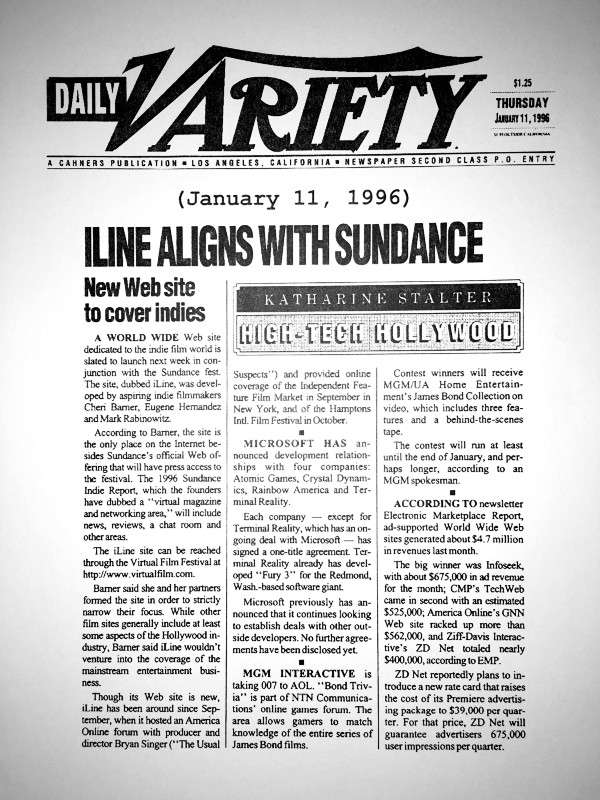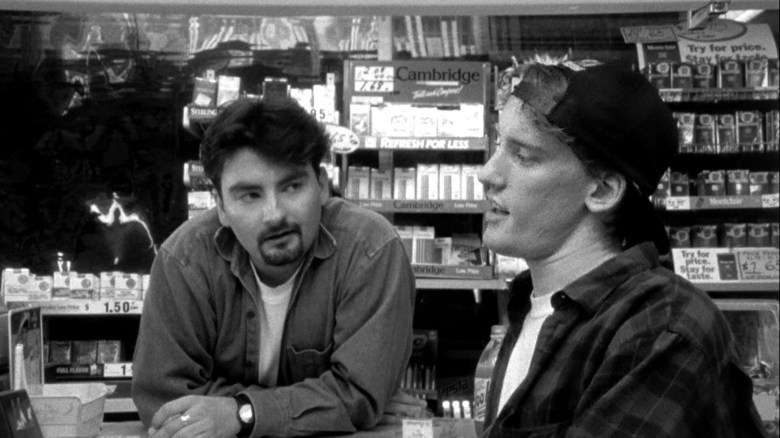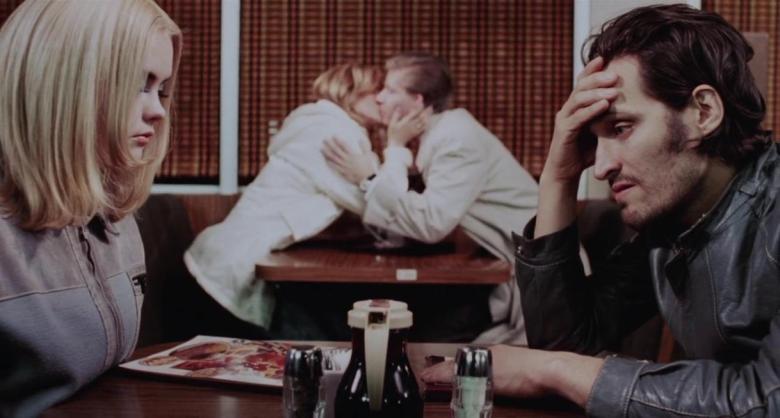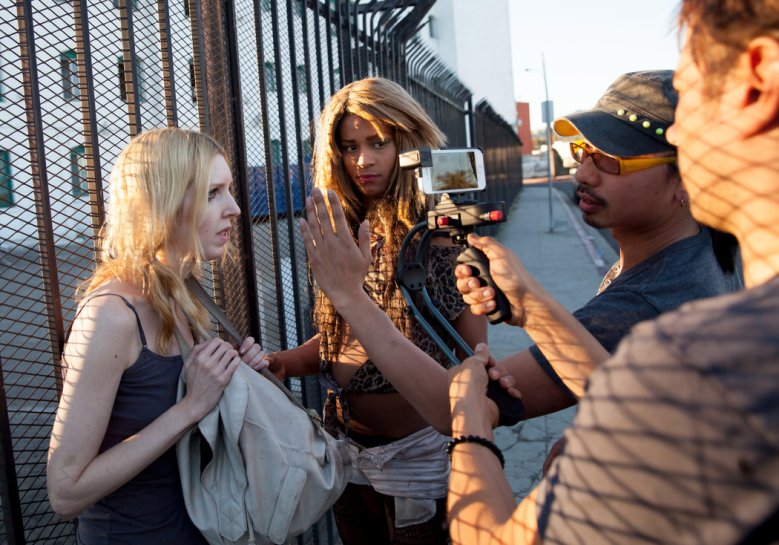By providing your information, you agree to our Terms of Use and our Privacy Policy. We use vendors that may also process your information to help provide our services. This site is protected by reCAPTCHA Enterprise and the Google Privacy Policy and Terms of Service apply.
IndieWire Turns 20: An Oral History of Supporting Filmmakers and Partying at Sundance From Those Who Lived It
Eric Kohn

On July 15, 1996, IndieWire launched as an e-mail newsletter providing “the daily news service for independent film.” (See the first newsletter here.) The original iteration of the site was the brainchild of Cheri Barner, Eugene Hernandez and Mark Rabinowitz, three recent college students obsessed with the movies. In the ensuing years, IndieWire grew and changed hands many times over. Barner now works as a talent manager in Los Angeles, Hernandez is the deputy director of the Film Society Lincoln Center, and Rabinowitz is a freelance publicist, consultant and programmer.
But they have remained a part of our close-knit community. As IndieWire arrives at its 20th anniversary, the trio gathered together for their first joint interview to recall the early days of IndieWire — as well as the thriving American independent film scene that inspired the publication.
EUGENE HERNANDEZ: IndieWire was an outgrowth of something that Mark, Cheri and I had started in 1995. At the time, I was working at ABC television. Cheri and I were close friends from school at UCLA. Mark and I met at Sundance two years before that. I had been working in multimedia and early web stuff. The three of us started a company called iLINE. It was intended to be an online community for independent filmmakers. IndieWire was the byproduct of that.
MARK RABINOWITZ: I was living in New York and not really doing much of anything. I was writing for myself. I’d gone to Sundance in ’93 with my mother and her best friend, who was also a cinematographer on a documentary that my mom had made. It was like a multi-year Busby Berkeley musical. That’s the way I remember the founding of IndieWire. We didn’t know what we couldn’t do. It was just, “Hey, there’s no home for independent film on AOL. Okay, let’s start one!” We all loved independent film and just wanted to carve out our space. We weren’t going to break out into print journalism. There were a few good print magazines around, like Film Threat. But we were more excited about the online world.
CHERI BARNER: It was pretty soon after getting out of college and I was trying to figure out what I wanted to do. I knew I wanted to do something in film. I loved independent and foreign film. Then Eugene and our friend Tim LaTorre came back from Sundance having had this incredible experience. They wanted to do something in independent film. Eugene and Mark were already in New York, so Tim and I had a lot of conversations about what we thought IndieWire could be — a place where people could learn and get excited about independent film and learn how it was made.
We would sit around my apartment talking about very idealistic ideas for what we could do to support independent film. We were just feeding off their excitement from Sundance. In 1994, we met in New York before Sundance and connected with Mark’s dad, who provided us with the first funds. We had our first general conversation about wanting to create something in the online space for independent film.
EH: Both of Mark’s parents — his mother, a documentary filmmaker, and his father, an activist lawyer — clicked with what we were trying to do. As our first investors, they were so supportive and open. It’s so important to acknowledge that contribution.
MR: Neither of them were particularly into new technologies — certainly not my father — but I think they understood the disruptive potential of this. Disrupting the status quo and starting something new that would help young and up-and-coming creative people was very attractive to both of them.

EH: These early conversations came together around iLINE being an online community. I found this early quote from September 1995 in Wired magazine: “Content is no longer king. Rather, building a community around that content is king.” That was said by Ted Leonsis, who later started SnagFilms, which acquired IndieWire in 2008. Back in nineties, Mark and I were talking a lot about what AOL was doing, and dreamed of getting AOL someday to invest in what we were doing. There’s a longer story Mark can tell someday about the actual trip we took down to AOL where we tried, unsuccessfully, to secure that funding.
After we went to Sundance in ’93, where I met Mark, we shared this experience with Cheri and other friends. I think we were most interested in community, first and foremost. It’s important to look at ’93 and ’94 as a combination: ’93 was the year of the “Twenty Somethings”: John Pierson moderated this panel introducing twenty-something filmmakers — Robert Rodriguez, Bryan Singer, Rob Weiss. Then ’94 was Kevin Smith’s “Clerks.”

So if you look at that combination of filmmakers that came out of Sundance, it’s different from what happened in ’91 and ’92. This was a very inspirational thing for us at that moment. People like us were making these movies. The previous generation just a few years earlier — Richard Linklater, Todd Haynes, Quentin Tarantino — somehow felt a little older. But these ’93-’94 filmmakers were somehow just like us.
MB: I realized during this time not to ignore short films. There was one that screened at the ’93 festival called “Bottle Rocket.”
EH: We connected with a lot of these filmmakers personally, hanging out with them. Later, we facilitated online chats with them. The ability to connect with these filmmakers on their first films was a real inspirational moment for all of these people. We were trying to harness that energy and also be supportive of that community.
MR: We didn’t start off our little website as journalists so much as we were community organizers. AOL had this function where you could search people’s profiles based on your interests. We put together these e-mail lists on AOL, so if you searched for “independent film” on there, you’d find us. We’d say, “Hey, we’re going to reserve a chat room and get filmmakers to talk about independent film.” That’s how we found people like Josh Moss and Mark Feinsod, who were regular writers for us. It quickly became this weekly online chat with several hundred people. People like Nicole Holofcener would participate. It was two years or so before we took what we were doing to a more focused, journalistic direction. The original point was all about community building and finding fans for these films.
CB: In ’94, we’d go see a film, meet the filmmaker, go back to their condo, and spend the rest of the night talking about film. There was this real ragtag feeling to it. Everybody was in it together. That was invigorating in a way I did not expect. The first interview I got on my second day of Sundance was with Hugh Grant — I don’t know why someone would allow Hugh Grant to do a half hour interview with someone who had never done one before, but they did.

EH: We had a list of advisers for iLINE. Among them were Mary Jane Skalski and Anthony Bregman from Good Machine, Bryan Singer, Chris McQuarrie, Lodge Kerrigan, Bill Plympton, David O. Russell, Adrienne Bowles, Jeff Hill, Laura Kim…these were some of the earliest allies who very quickly saw the potential. These folks just got it. We just tried to harness that trust. And now we’ve grown up with all of them in the business.
MR: Quite a few of them were not big veterans in the industry yet. They hadn’t been plugging away since the sixties like Ben Barenholtz. They were all relatively newbies, too.
EH: Cheri’s early interviews had a very natural, conversational spark. Mark was IndieWire’s socializer, always out front, talking to everybody. He met Karol Martesko and brought him into the fold; Karol brought Brian Clark into the fold. The stuff I gravitated towards were the more business-oriented stories — tracking the deals. In 1997, we broke the story about Miguel Arteta’s “Star Maps” getting acquired by Fox Searchlight.
MR: It wasn’t until we started doing print dailies that we started scooping the trades on a regular basis. They were shipping their copies in from L.A. We could find out at party that something was picked up, go back to our office, and beat the trades by a day.
Related indieWIRE Celebrated An Anniversary, And All I Got Was This Lousy Hangover — The Rabbi Reports
EH: We very quickly saw our potential to be a disruptive trade. That disruption — and the thoughtfulness of our coverage — carried us through two decades. It’s ironic that, since IndieWire is owned by Penske Media, it’s now working alongside Variety, a friendly nemesis to us for so long.
MR: The memory that sticks in my mind was during Cannes one year, there was some deal going down, and we were frantically trying to get ahold of super-agent Cassian Elwes. He called us late at night from the room of some party at Cannes to tell us about this deal that had gone down. I remember hanging up the phone in disbelief. I hadn’t thought we could get a call like that at that time. I realized people were taking us seriously when we got calls from parties at three o’clock in the morning.
CB: People started allowing us to do more interviews. One of the first things I always said when I sat down was, “I don’t care about your personal life.” We cared about their films and how to have conversations about them. We were creating a space for artists to talk with people who cared about what they were doing.
MR: I was also very proud the first time somebody tried to sue us — Vincent Gallo and the DGA went after us in 1998. He did an interview there about “Buffalo ’66” wherein he referred to Angelica Huston as a “cunt.” We reported that. He didn’t like that. But it was open to the public and we had a right to report it. That just made me happy.

EH: It goes without saying that I have deep pride for everything IndieWire has achieved. It’s crazy that after 20 years, the site is still alive. There were so many moments where the company almost didn’t survive. The fact that Ted Leonsis bought the company was transformational in 2008. Then Jay Penske had the foresight to take the company to the next level, putting it right alongside Variety, the ultimate compliment. As much as film has changed in the ensuing years, what hasn’t changed is the ingenuity of independent filmmakers.
MR: Eugene stuck with IndieWire much longer than I did. I always joked that I was the Steve Wozniak of IndieWire and he was more Steve Jobs. But I watched IndieWire grow, thinking some things were great and others weren’t. I remember when IndieWire started covering television and I thought, look, I love television, but I don’t really see why it relates to IndieWire. That’s possibly because I wasn’t in the industry as much. Recently, Eugene and I went to Seriesfest, and I saw these 34 content creators they had there, and it really felt like Sundance in ’93 and ’94. They were mostly young, excited content creators doing something that even five years was unthinkable — there was no independent television. But Netflix and Amazon and YouTube Red and whatever else are now allowing for a whole new area of ideas. It just blows my mind.
CB: Now that I manage talent, I see a little bit of that as well. Nowadays, where you say something isn’t as important as having something to say. IndieWire had to broaden its scope. I just hope IndieWire doesn’t stop shining a light on those little independent films, which I think are the future. When you see something like “Tangerine,” this little voice that would not be heard in any other way — where someone can make something unique, special and really talk about something that nobody else would shine a light on in a very personal way — those things are the heart of what got me excited about independent film in the first place. It’s not for nothing that iLINE was started by two biracial people and a Latino.

To be able to see unique voices that aren’t necessarily shown in the mainstream was one of the most exciting aspects of IndieWire, and it’s the most exciting thing about independent film, period. My hope is that filmmakers will continue to do that.
EH: These are conversations we had 20 years ago that led to what we created. But now we’re transposing them onto the new directions that culture and entertainment have headed.
CB: And we haven’t become old curmudgeons! We’re still idealists.
By providing your information, you agree to our Terms of Use and our Privacy Policy. We use vendors that may also process your information to help provide our services. This site is protected by reCAPTCHA Enterprise and the Google Privacy Policy and Terms of Service apply.

















